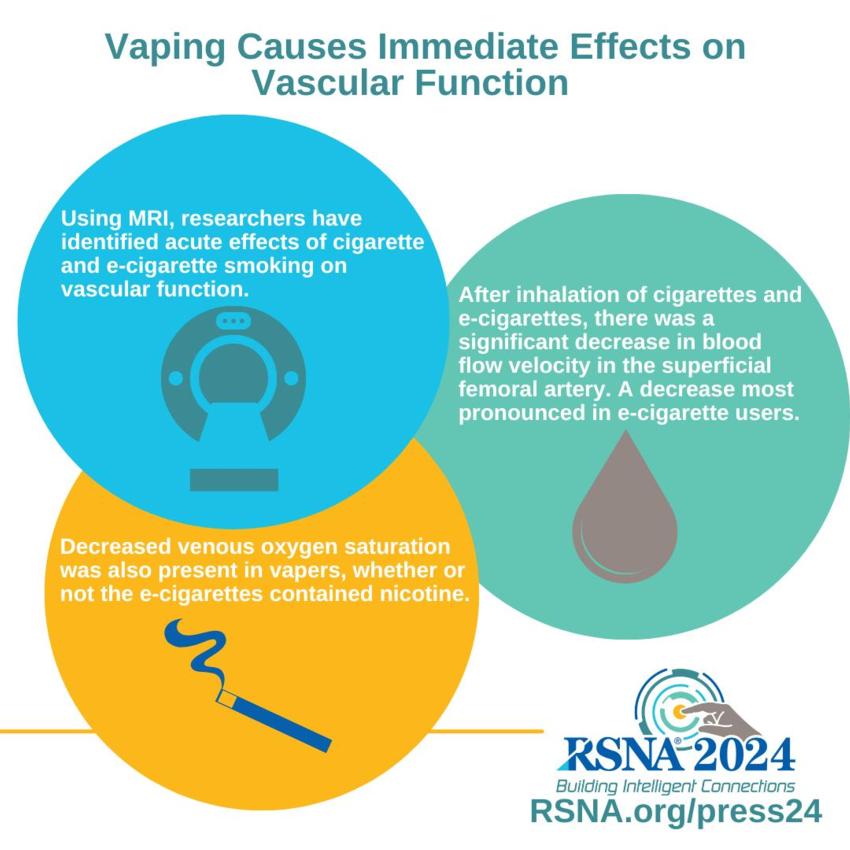Vaping Causes Immediate Effects on Vascular Function
Released: November 25, 2024
At A Glance
- Using MRI, researchers have identified acute effects of cigarette and e-cigarette smoking on vascular function.
- After cigarette or e-cigarette inhalation, there was a significant decrease in resting blood flow velocity in the superficial femoral artery, especially in e-cigarette users.
- Decreased venous oxygen saturation was also present in vapers, whether or not the e-cigarettes contained nicotine.
- RSNA Media Relations
1-630-590-7762
media@rsna.org - Linda Brooks
1-630-590-7738
lbrooks@rsna.org
CHICAGO — Researchers have identified acute effects of cigarette and e-cigarette smoking on vascular function, even without nicotine. The results of the ongoing research are being presented next week at the annual meeting of the Radiological Society of North America (RSNA).
E-cigarettes, also known as vapes, are battery-operated devices that heat a liquid to produce an aerosol, which is then inhaled into the lungs. Vapes contain significantly fewer chemicals and toxins than are found in tobacco smoke. As a result, e-cigarettes are believed by many to be less harmful than cigarette smoking. Vapes also come in various flavors, making them popular among young people.
“E-cigarettes have long been marketed as a safer alternative to regular tobacco smoking,” said study lead author Marianne Nabbout, M.D., a radiology resident at the University of Arkansas for Medical Sciences in Little Rock. “Some believe that e-cigarettes don’t contain any of the harmful products, such as free radicals, found in regular tobacco cigarettes, because no combustion is involved.”
While vaping exposes users to fewer toxic chemicals than cigarettes, it can still be detrimental to vascular function and overall health.
In the study conducted at the University of Pennsylvania, Dr. Nabbout and colleagues sought to identify the acute effects on vascular function of cigarette smoking and the immediate effects of e-cigarette vaping, with and without nicotine.
A total of 31 healthy smokers and vapers ranging in age from 21 to 49 years have been included to date. In three separate sessions, study participants underwent two MRI exams, one before and one after each of the following smoking/vaping episodes: tobacco cigarette, e-cigarette aerosol with nicotine and e-cigarette aerosol without nicotine.
A cuff was placed on the upper thigh to restrict blood flow. Once deflated, femoral artery flow velocity (a measure of the speed of blood flow in the femoral artery) and venous oxygen saturation (a measure of the amount of oxygen in the blood that returns to the heart after supplying oxygen to the body’s tissues) were evaluated.
Cerebrovascular (blood flow in the brain) reactivity was measured with a special type of MRI called phase-contrast MRI.
The data of the smokers and vapers was then compared to the baseline scans of 10 non-smokers and non-vapers ranging from 21 to 33 years old.
Following inhalation of each type of vaping or smoking, there was a significant decrease in the resting blood flow velocity in the superficial femoral artery. This artery runs along the thigh and supplies oxygenated blood to the entire lower body.
The decrease in vascular function was most pronounced after inhalation of e-cigarettes containing nicotine, followed by e-cigarettes without nicotine.
Decreased venous oxygen saturation was also present in vapers, whether or not the e-cigarettes contained nicotine. This suggests an immediate decrease in the uptake of oxygen by the lungs after vaping.
“This study serves to highlight the acute effects smoking and vaping can have on a multitude of vascular beds in the human body,” Dr. Nabbout said. “If the acute consumption of an e-cigarette can have an effect that is immediately manifested at the level of the vessels, it is conceivable that the chronic use can cause vascular disease.”
According to Dr. Nabbout, the take-home message for the public is that vaping may not be free of harm. “Ultimately, we are relying on science to help guide the regulation of such products in favor of public health,” she said. “Refraining from smoking and vaping is always recommended.”
This research project is supported by the National Institutes of Health.
Co-authors are Michael C. Langham, Ph.D., Alessandra Caporale, Ph.D., Shampa Chatterjee, Ph.D., Frank T. Leone, M.D., M.S., Andrew Strasser, Ph.D., Christiana Cottrell, B.A., Rasleen Grewal, B.S., and Felix W. Wehrli, Ph.D.
Note: Copies of RSNA 2024 news releases and electronic images will be available online at RSNA.org/press24.
RSNA is an association of radiologists, radiation oncologists, medical physicists and related scientists promoting excellence in patient care and health care delivery through education, research and technologic innovation. The Society is based in Oak Brook, Illinois. (RSNA.org)
Editor’s note: The data in these releases may differ from those in the published abstract and those actually presented at the meeting, as researchers continue to update their data right up until the meeting. To ensure you are using the most up-to-date information, please call the RSNA Newsroom at 1-312-791-6610.
For patient-friendly information on vascular imaging, visit RadiologyInfo.org.
Video (MP4):

Video: Marianne Nabbout, M.D., discusses her research on how vaping causes immediate effects on vascular function.
Download MP4
(Right-click and Save As)
Images (JPG, TIF):

Figure 1. Cuff occlusion paradigm: (a) Cross-sectional images of the femoral artery used to draw regions of interest before (rest) and after cuff occlusion (at three different time points) to determine flow mediated dilation (FMD). (b) Femoral vein oxygen saturation (SvO2) plotted vs time after cuff release. SvO2 is derived from the difference between venous and arterial signal phase. (Tw = washout time) (c) Average blood flow velocity-time curve in the femoral artery. (HI = hyperemic index; Vp = peak velocity; Tp = time to peak velocity; TFF = time of forward flow)
High-res (TIF) version
(Right-click and Save As)

Figure 2. E-cigarette components: Superior envelope (1), mouthpiece (2), light emitting diode (3), cylindrical 3.7-V lithium battery (4), wick and filament (5), thick wire (6), inner fibers (7), and outer fibers (8).
High-res (TIF) version
(Right-click and Save As)
Additional Resources

